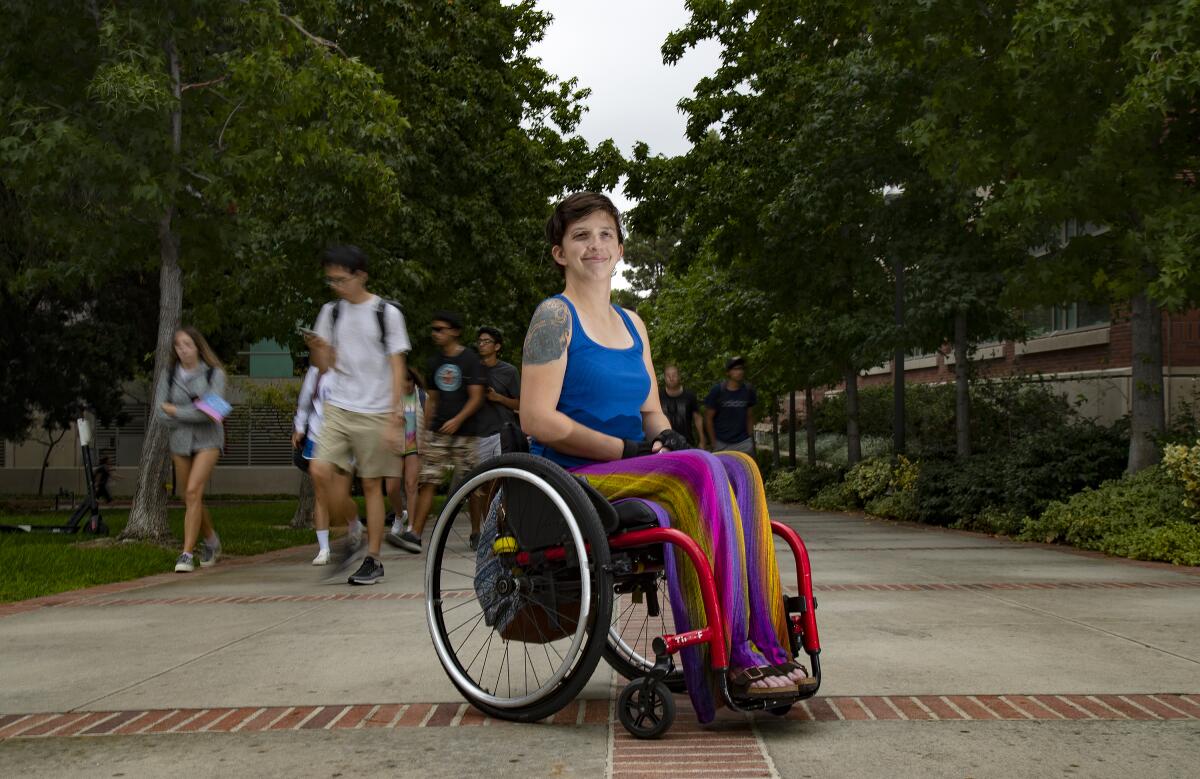Column: For L.A.’s disabled people, scooters and bad sidewalks aren’t the only hazards

For months as I’ve walked L.A.’s increasingly chaotic sidewalks, I’ve wondered how I would manage them in a wheelchair.
How I would get around the e-scooters left strewn across my path and the ones zooming toward me even though they’re supposed to be on the street. The many stretches of root-buckled pavement that slope wonkily this way and that. All the tents.
I thought I had identified a central problem for disabled people, but I had iceberg vision. What I’d been noticing, I have since been schooled, is just one small, exposed part of a mass of afterthought and neglect invisible to most of us.
David Radcliff can’t ignore it. He lives it. He regularly finds himself in places where his passage is hampered or impossible.
“It’s like going into the Matrix. You see the world in a very different way,” said the 36-year-old television writer, who worked on “The Rookie” and who has cerebral palsy. We should all pay better attention, he said: “Disability isn’t something that’s going to happen for other people. It’s going to happen for just about everybody.”
And if and when it does, unless we get informed and involved beforehand, the breadth of what changes in our lives will be jarring.
Yes, messy sidewalks are hard. But so are shops and restaurants with steps at their entrances. So are blocks that lack curb cuts or have ones that are poorly designed. So are broken elevators. So is the fact that in L.A., if you’re a disabled person (which is what Radcliff calls himself rather than a person with a disability), you generally have to spend more on rent, because the properties covered by rent stabilization are older ones less likely to be accessible.
More broadly, accommodating disability is often done in such a perfunctory, ungracious manner that it makes disabled people feel “othered,” lesser and separated from the rest of us.
Radcliff says its not uncommon for him to be directed to a restaurant’s alleyway to find the only wheelchair-accessible entry. Once when he and a friend went to a concert at Pershing Square and staked out a spot on the grass, a guard told them they they were fire hazards (which became the name of their trivia team). He made them move to what was essentially a concrete pen — with a sign on it that said “ADA,” for the Americans With Disabilities Act.
My original plan when I was focused on the sidewalks was to interview a lot of people who roll along them in wheelchairs — but the first two I reached, Radcliff and UCLA computer programmer Kat Kath, taught me so much so fast. They made me see that this is a highly complex subject, which I will have to return to and explore in parts. They also gave me a basic tutorial that I will try to give to you.
Because we all — individuals, urban planners, architects, developers, designers, city employees — need to work harder to make the way smoother for Radcliff, Kath and others. And to think about how to more fully accommodate and respect those who have greater needs than the majority of us.
Respect is key, as I’ve said before. Also, sometimes even the most well-intentioned help isn’t helpful.

Kath, who is 30 and also refers to herself as a disabled person, pushes her own weight plus the 25 pounds of her wheelchair all day. She participates in an adaptive rowing program. Still, she told me, she often is infantilized or treated paternalistically by strangers who have no idea how very capable she is.
She has a variety of serious conditions, including Ehlers-Danlos syndrome hypermobility type, a genetic disorder that causes her joints to pop out easily — and, of course, painfully. Jumping in to help her without being asked can injure her. And yet people often do so. And even when they ask, they often either don’t wait for or listen to her reply.
Kath still feels residual anxiety from when a stranger startled her by calling out to her and then began pushing her wheelchair without her OK. In that moment, Kath dislocated a shoulder and a rib.
“We talk a lot in this #MeToo culture about how no means no — but consent doesn’t just apply to sexual relations. Consent is everywhere,” she told me. “So take me at my word. When I say, ‘No, I’ve got the door’ — what, am I lying?”
The prevalence of disability, by the way, is not debatable. Both Kath and Radcliff made the point that it is a common factor in homelessness, and that those living on the streets are often well-versed in it and considerate of others’ disabilities. (Tents, they told me, pose a far smaller problem than unthinking city planners and developers.)
According to the Social Security Administration, for those who are 20 now, the odds of being disabled by retirement age are greater than 1 in 4.
And when I asked Times data reporter Sandhya Kambhampati to crunch the census numbers, she found that in both our city and our county, 1 in 10 civilians who are not institutionalized report at least one form of disability, whether it be related to hearing, vision, cognition, walking, difficulty bathing or dressing or living independently.
When it comes to mobility, I couldn’t have had a better guide than Radcliff, who does not own a car and travels the city widely using a wheelchair and crutches. He not only spoke to me frankly about his daily life, he took me out to experience it. One afternoon, we set off from a Starbucks in Studio City, where he lives, first to downtown L.A. to be in a crowd, and then to USC to take his laptop to a repair shop.
From the get-go, the trip was eye-opening to me, starting with leaving the Starbucks in a busy shopping mall — which David had to do where cars entered and exited because the sidewalk in front of the shops didn’t continue all the way to the exit. It’s hard enough as a pedestrian in L.A. to trust that distracted drivers will notice you in a crosswalk. But imagine not being in a crosswalk and not being at their eye level.

Getting from coffee to the Red Line went pretty smoothly. So did getting to Pershing Square station. Looking at that station through Radcliff’s eyes, though, was new to me.
Did you ever stop to think that the same kind of planning designed to deny homeless people places to sleep also denies comfort to others who have physical problems and might need to take a seat and rest? I hadn’t until Radcliff pointed it out after we’d come up from the train platform in one elevator and were moving toward the second elevator required to take us to street level. We were in a big space with smooth walls and no seating. On his crutches, he said, he probably would have wanted to sit down.
We were talking about that when we got to the second elevator, located to the right of steep escalators and stairs. In front of its closed door were yellow tape and yellow traffic cones that read “CAUTION: WET FLOOR.” On the wall, a sign: “NOTICE: ELEVATOR OUT OF SERVICE.” The sign had blanks to fill in to inform “patrons with disabilities” which bus lines they could take instead — though no one had bothered to fill in the blanks and Radcliff couldn’t reach the street to take a bus anyway.
So we had to backtrack to another station — which, because we’d already been through the turnstiles, meant we had to pay another fare to get back on a train. It was one headache of many.
At the next stop we tried, 7th Street/Metro Center, getting to the street also required two elevators, separated this time by a long stretch of below-ground shopping mall — in which some sort of event was being set up and a raised cover protected the production’s wires at the expense of a smooth ride for wheelchairs.
At USC, we came off the Expo Line to a sidewalk closed for construction, then made it to the repair shop, where the counters were well above Radcliff’s head. On the way back to the train, we came to a spot straight out of my initial anxiety — a scooter blocking the way followed by root-warped sidewalk.
Radcliff made it past the scooter, then up one side of the steepled cement. Coming over its lip, he hit a dip and tumbled out of his chair.
He wasn’t hurt. People ran to help. But watching my fears come to life for a new friend felt terrible. It made me feel as scraped up inside as if it had happened to me.
I’m starting to think that’s how we’ll all have to feel before, as a society, we’ll do better on so many fronts: This could be us. Therefore, this is unacceptable.
More to Read
Start your day right
Sign up for Essential California for news, features and recommendations from the L.A. Times and beyond in your inbox six days a week.
You may occasionally receive promotional content from the Los Angeles Times.







